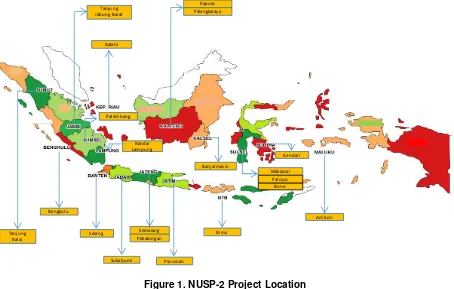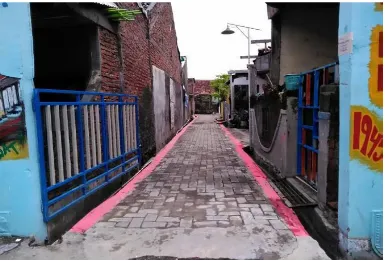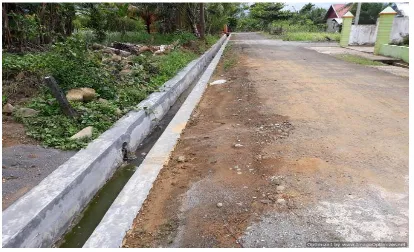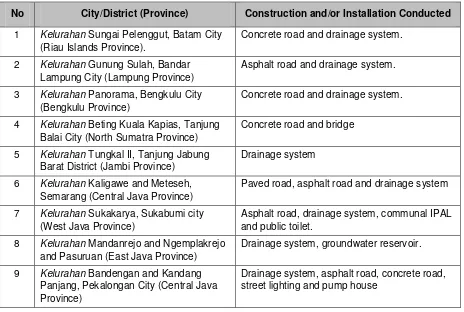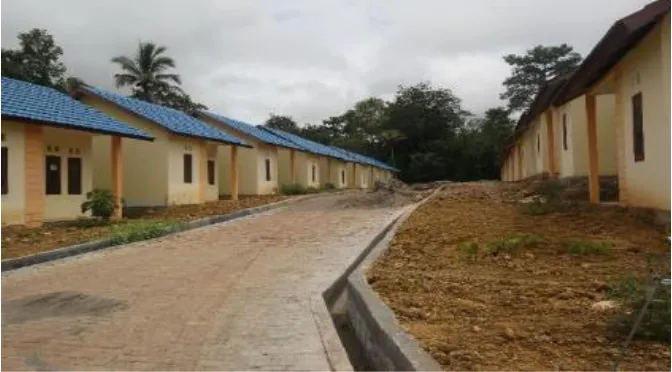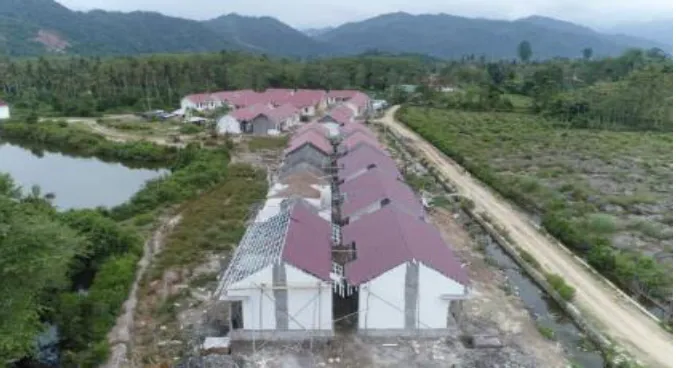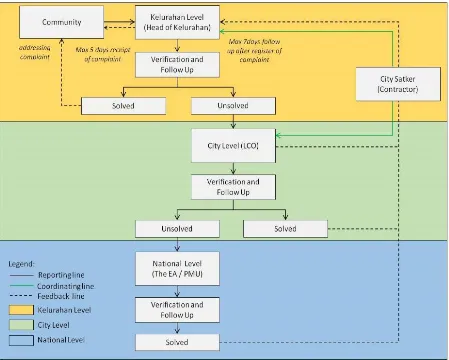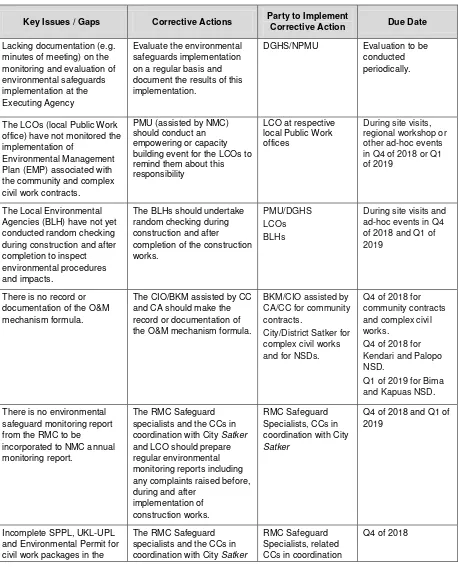Environmental Monitoring Report
# Annual Report December 2018
Indonesia: Neighborhood Upgrading and Shelter
Project – Phase 2
Currency unit – rupiah currency name in lowercase (Rp) Rp1.00 = $0.00007
$1.00 = Rp14,240
ADB – Asian Development Bank
APBD – Anggaran Pendapatan and Belanja Daerah (Regional Budget Income and Expenditure)
DGHS – Directorate of Human Settlements
NOTE
(i) The fiscal year (FY) of the Government of Indonesia and its agencies ends on 31 December. “FY” before a calendar year denotes the year in which the fiscal year ends, e.g., FY2011 ends on 31 December 2011.
(ii) In this report, "$" refers to US dollars.
This environmental monitoring report is a document of the borrower. The views expressed herein do not necessarily represent those of ADB's Board of Directors, Management, or staff, and may be preliminary in nature.
___________________________________________________________________________
2017 ANNUAL ENVIRONMENTAL MONITORING REPORT
ADB LOAN 3122-INO: Neighborhood Upgrading and Shelter Project
Phase 2 (NUSP-2)
Bridge constructed at Beting Kuala Kapias Neighborhood
Prepared by
Directorate General of Human Settlements - Ministry of Public Works and Housing
for
Asian Development Bank
Table of Contents
Table of Contents ... 2
List of Tables ... 3
List of Figures ... 3
ABBREVIATIONS ... 4
CHAPTER 1. INTRODUCTION ... 5
CHAPTER 2. KEY PROJECT ACTIVITIES AND PROGRESS ... 7
2.1. Community Contracts ... 7
2.2. Complex Civil Work Contracts ... 9
2.3. New Site Development (NSD) ...11
CHAPTER 3. ENVIRONMENTAL MITIGATION AND MONITORING STATUS ...13
3.1. Requirements of Environmental Safeguards ...13
3.2. Key Roles and Responsibilities ...13
3.3. Community Contracts ...15
3.4. Complex Civil Work Contracts ...16
3.5. New Site Development Contracts ...16
CHAPTER 4. PUBLIC CONSULTATION AND DISCUSSION ...17
CHAPTER 5. INFORMATION DISCLOSURE ...18
CHAPTER 6. GRIEVANCE REDRESS MECHANISM ...19
CHAPTER 7. PROJECT STAFFING AND CAPACITY BUILDING ...21
CHAPTER 8. KEY ISSUES AND CORRECTIVE ACTIONS ...23
CHAPTER 9. CONCLUSIONS AND RECOMMENDATIONS ...25
APPENDICES Appendix 1. SPPL of Community Contracts ... 27
Appendix 2. UKL-UPL and SPPL of Complex Civil Work Contract ... 29
Appendix 3. UKL-UPL and Environmental Permit for the New Site Development ... 31
List of Tables
Table 1. Community Contracts Awarded in 2017 ... 8
Table 2. Complex Civil Works Contracts Awarded in 2017 ... 10
Table 3. Agency and Community Organization Responsibilities ... 13
Table 4. Key Issues and the Corrective Actions ... 23
List of Figures Figure 1. NUSP-2 Project Location ... 5
Figure 2. Construction of neighborhood road in Muktiharjo Kidul (Semarang City) ... 7
Figure 3. Construction of drainage system in Kelurahan Dusun Besar (Bengkulu City) ... 8
Figure 4. Bridge Construction in Kelurahan Beting Kuala Kapias (Tanjung Balai) ... 10
Figure 5. Progress of NSD Development ... 12
ABBREVIATIONS
ADB Asian Development Bank
BLH Badan Lingkungan Hidup (Local Environment Office)
CA Community Advisor
CAP Community Action Plan
CC City Coordinator
CIO Community Implementing Organization (or BKM Badan Keswadayaan
Masyarakat)
CPMU Central Project Management Unit
DGHS Directorate General of Housing Settlements
EA Executing Agency
EARF Environmental Review and Assessment Framework
EIA Environmental Impact Assessment
EMP Environmental Management Plan
EMS Environmental Management System
FY Fiscal Year
IEE Initial Environmental Examination
IPAL KPP
Instalasi Pengolahan Air Limbah (Communal Wastewater Treatment Plant)
Kelompok Pemanfaat dan Pemelihara (Operation and Maintenance Team)
LCO Local Coordinating Office
MDG Millennium Development Goals
MPWH Ministry of Public Work and Housing
Muskel Musyawarah Kelurahan (neighborhood assembly meeting)
NMC National Management Consultant
NSD New Site Development
NUSP-2 Neighborhood Upgrading and Shelter Project Phase 2
O&M Operation and Maintenance
PIP Pengembangan Infrastruktur Permukiman (Settlement Infrastructure
Development)
PIU Project Implementing Unit (Satker or Satuan Kerja)
PMU Project Management Unit
RAB Rencana Anggaran Belanja (Budget Planning)
RMC Regional Management Consultant
Satker Satuan Kerja (Project Implementing Unit)
SKS Survey Kampung Sendiri or Village Survey
SPPL Surat Pernyataan Kesanggupan Pengelolaan dan Pemantauan Lingkungan
(Statement Letter for Environmental Management and Monitoring) TIPP Tim Inti Perencanaan Partisipatif (Core team for Participatory Planning) UKL-UPL Upaya Pengelolaan Lingkungan – Upaya Pemantauan Lingkungan
CHAPTER 1. INTRODUCTION
1. Project Background. The Neighborhood Upgrading and Shelter Project – Phase 2 (NUSP-2) is aimed to upgrade basic public infrastructure in slum settlements, and contribute to meeting Millennium Development Goal (MDG) targets for achieving significant improvement in the lives of slum dwellers (MDG target 7D) and halving the proportion of urban households without sustainable access to safe drinking water and basic sanitation (MDG target 7C).1 The NUSP-2 also contributes to the implementation of Cities without Slums Program launched by the Indonesian Government.2
2. The NUSP-2 is an ADB-funded project, particularly upgrading and/or developing basic infrastructure and facilities for selected slum areas at 209 neighborhoods (kelurahan). These neighborhoods are distributed in 20 districts (kabupaten) and municipalities (kota) located across Sumatra, Java, Kalimantan, Sulawesi, Nusa Tenggara and Maluku Islands as shown in Figure 1. The executing agency of the NUSP-2 is the Directorate General of Human Settlements (Direktorat Jenderal Cipta Karya) of the Ministry of Public Works and Housing (MPWH).
Figure 1. NUSP-2 Project Location
1 The 2015 MDG target for the proportion of the urban population living in slums is 6%; in 2011, 12.6% of the
urban population lived in slums. The 2015 MDG target for the proportion of households with sustainable access to an improved water source is 75.5%; in 2011, 40.5% of urban households had access to an improved water source, 72.5% had access to basic sanitation. The proportion of households with access to safe water and basic sanitation in slum areas is assumed to be much lower.
2 The Cities without Slums Program is incorporated in the National Long-Term Development Plan, 2005–2025. It
aims to reduce slum areas in cities by 2025 by promoting concerted initiatives by the central and local governments, private sector, and civil society.
3. The NUSP-2 assists the local governments in upgrading and/or developing basic infrastructure and facilities at selected neighborhoods in order to achieve the following: Output 1: Institutional capacities for managing pro-poor urban development strengthened; Output 2: Infrastructure in slum neighborhoods upgraded; and Output 3: New settlements for poor families established.
4. There are seven types of infrastructures and facilities built under the NUSP-2, among others, construction of road, bridge, basic sanitation facilities, and communal wastewater treatment plant; installation of clean water supply and street lighting; and provision of municipal solid waste handling facility and transportation as well as basic fire-fighting equipment.
CHAPTER 2. KEY PROJECT ACTIVITIES AND PROGRESS
6. This chapter summarizes key project activities and progress associated with the NUSP-2 implementation in 2017. These include the community and complex civil work contracts awarded as well as the construction of neighborhood infrastructure and facilities to be constructed as part of the new site development (NSD) during the reporting period.
2.1. Community Contracts
7. In 2017 the NUSP-2 awarded 208 community contracts for neighborhood upgrading civil works (skala lingkungan) to local Community Implementation Organizations (CIO). Construction works that are considered technically modest and can be conducted by the community without using specialized or heavy equipment qualify for the community-typed contracts mentioned earlier. Figure 2 and Figure 3 are examples of the construction works awarded under the community contract scheme.
Figure 3. Construction of drainage system in Kelurahan Dusun Besar (Bengkulu City)
Table 1 provides information on 209 community contracts awarded in 2017 as part of the NUSP-2 implementation at 20 cities and districts in Indonesia.
Table 1. Community Contracts Awarded in 2017
No City/District (Province)
Number of Neighborhoods
Involved
Construction and/or Installation Conducted
1 Tanjung Balai City (North Sumatra Province)
15 Concrete paved road, drainage system, culvert, and bridge.
2 Tanjung Jabung Barat District (Jambi Province)
9 Road and drainage system.
3 Palembang City
(South Sumatra Province)
20 Vase, bench and street lighting.
Concrete paved road, bridge, and solid waste collection area.
4 Bengkulu City (Bengkulu Province)
10 Street lighting.
Concrete paved road, drainage channel, retaining wall, and provision of clean water well.
5 Bandar Lampung City (Lampung Province)
16 Street lighting.
Concrete paved road, drainage channel, retaining wall, clean water well and toilet.
6 Batam City
(Riau Islands Province)
6 Concrete paved road and drainage channel.
7 Sukabumi City (West Java Province)
12 Concrete paved road, drainage channel, communal septic tank and waste water treatment plant, retaining wall, hand dug and bore water wells.
8 Semarang City (Central Java Province)
17 Concrete road and bridge, drainage channel, public toilet, solid waste collection area, and street light installation.
No City/District (Province)
Number of Neighborhoods
Involved
Construction and/or Installation Conducted
(Central Java Province) light, and green open space.
10 Pasuruan City (East Java Province)
11 Concrete road and bridge, drainage channel, communal septic tank, and purchase of garbage collector vehicle
11 Serang City (Banten Province)
7 Concrete road and bridge, drainage channel, public toilet, retaining wall, hand-dug well, solid waste collection area, and purchase of garbage collector vehicle
12 Kapuas District (Central Kalimantan Province)
10 Concrete road, wooden bridge, wooden trails road, public toilet, and drainage channel.
13 Palangka Raya City (Central Kalimantan Province)
8 Wooden trails road, concrete and paving road, and drainage channel.
14 Banjarmasin City (South Kalimantan Province)
11 Installation of culvert, concrete road and bridge, and drainage channel.
15 Bima City (West Nusa Tenggara Province)
9 Drainage channel, concrete road and bridge.
16 Bone City (South Sulawesi Province)
4 Drainage channel and concrete road.
17 Makassar City (South Sulawesi Province)
12 Drainage channel, concrete road, and communal septic tank.
18 Palopo City
(South Sulawesi Province)
9 Drainage channel, concrete road, public toilet, retaining wall, purchasing of waste bins, installation of clean water pipeline, and green open space
19 Kendari City
(South East Sulawesi)
10 Concrete road and bridge, wooden road, hand-dug well, drainage channel, and purchase of garbage motor vehicle.
20 Ambon City (Maluku Province)
6 Drainage channel, retaining wall, concrete road, and purchase of garbage motor vehicle and waste bins.
Source: NUSP-2 Management Information System (2017).
2.2. Complex Civil Work Contracts
Figure 4. Bridge Constructed at Kelurahan Beting Kuala Kapias (Tanjung Balai)
9. The types of community facilities and infrastructure constructed or installed in 2017 under the complex civil works contracts at more than 20 neighborhoods (kelurahans) and cities distributed in 13 provinces in Indonesia are presented in the following table.
Table 2. Complex Civil Works Contracts Awarded in 2017
No City/District (Province) Construction and/or Installation Conducted
1 Kelurahan Sungai Pelenggut, Batam City (Riau Islands Province).
Concrete road and drainage system. 2 Kelurahan Gunung Sulah, Bandar
Lampung City (Lampung Province)
Asphalt road and drainage system. 3 Kelurahan Panorama, Bengkulu City
(Bengkulu Province)
Concrete road and drainage system. 4 Kelurahan Beting Kuala Kapias, Tanjung
Balai City (North Sumatra Province)
Concrete road and bridge 5 Kelurahan Tungkal II, Tanjung Jabung
Barat District (Jambi Province)
Drainage system 6 Kelurahan Kaligawe and Meteseh,
Semarang (Central Java Province)
Paved road, asphalt road and drainage system 7 Kelurahan Sukakarya, Sukabumi city
(West Java Province)
Asphalt road, drainage system, communal IPAL and public toilet.
8 Kelurahan Mandanrejo and Ngemplakrejo and Pasuruan (East Java Province)
Drainage system, groundwater reservoir. 9 Kelurahan Bandengan and Kandang
Panjang, Pekalongan City (Central Java Province)
No City/District (Province) Construction and/or Installation Conducted
10 Kelurahan Selat Dalam, Kapuas District, (Central Kalimantan Province)
Draiange system, 3R integrated waste management areas, and purchasing of waste containers
11 Kelurahan Dara, Bima City (West Nusa Tenggara Province)
Draianage system and asphalt road
12 Kelurahan Lette, Tamarunang and Bunga Eja Beru, Makassar (South Sulawesi Province)
Paved road, drainage system and perimeter fence
13 Kelurahan Ponjalae, Palopo (South Sulawesi Province)
Drainage system and installation of concrete plate
14 Kelurahan Lalolara, Kendari (South-East Sulawesi Province)
Asphalt road, drainage and public open space.
15 Kelurahan Karang Panjang and Rijali, Ambon, (Maluku Province)
Concrete road, pedestrian, drainage system, reinforce bridge, retaining Wall, landscaping, communal wastewater treatment plant, and passive hydrant.
16 Kelurahan Lonrae, Bone City (South Sulawesi Province)
Concrete bridge and road.
Source: NUSP-2 Management Information System (2017).
2.3. New Site Development (NSD)
10. As part of the ADB funding, the NUSP-2 plans to construct neighborhood facilities and infrastructures at four new site developments (NSD) in Purirano (Kendari City), Sampoddo (Palopo City), Handil Berkat (Kapuas District), and Jatiwangi (Bima City). The facilities and infrastructure to be constructed include paving roads, drainage system, clean water supply, solid waste management system and landscape for open green space for the newly built neighborhood. The NSD construction work is also implemented by contracted firms selected through bidding process. As of 2017, some houses in the NSD of Kendari and Palopo Cities have been developed; and land preparation/clearing for the NSD in Kapuas District and Bima City is being progressed.
11. Figure 5 presents the status of four NSD sites as of 2017. The houses in the NSD are developed by the DGHS and local governments.
Sampoddo NSD
Handil Berkat NSD
Jatiwangi NSD
CHAPTER 3. ENVIRONMENTAL MITIGATION AND MONITORING STATUS
3.1. Requirements of Environmental Safeguards
12. According to the ADB’s Safeguard Policy Statement (2009), the NUSP-2 is classified as the Category B Project, i.e. the project could have some adverse environmental impacts, but of lesser degree or significance than those in category A, but the impacts are site specific and can be readily addressed through common mitigation measures. The NUSP-2 creates positive impacts on the environment and improves the wellbeing of the community through alleviation of slum areas in emerging cities in Indonesia.
13. The Environmental Assessment and Review Framework (EARF) document has been prepared in 2014, and it provides screening procedure and checklist to review environmental implications of the infrastructure and facility to be constructed as part of the NUSP-2. The EARF requires that:
An initial environmental examination (IEE) document according to the ADB requirement is prepared and endorsed by DGHS and ADB as part of the new site development (NSD) proposal; and
Environmental Mitigation and Monitoring Plan (UKL-UPL) or Statement Letter to Conduct Environmental Mitigation and Monitoring (SPPL) is prepared and endorsed by DGHS according to the Ministry of Environment Regulations No. 5/2012 on Types of Activities and/or Projects Requiring Environmental Impact Assessment (AMDAL) and No. 16/2012 on the Guidance for the Preparation of Environmental Documents; and Ministry of Public Work Regulation No. 10/PRT/M/2008 on Types of Activities and/or Projects in the Public Work Sector Subject to be Completed with the Environmental Management Effort-Environmental Monitoring Effort (UKL-UPL) document.
3.2. Key Roles and Responsibilities
14. Table 3 summarizes the key roles and responsibilities of the executing and implementing agencies as well as community organizations involved in the implementation of the NUSP-2 including their respective environmental responsibilities. Related evidences as an example on the undertaking of these roles and activities, particularly at the city/district level, community implementing organization (CIO), and neighborhood level are included in Appendices 1 to 4.
Table 3. Agency and Community Organization Responsibilities
Institutions and Responsibilities Activities and Status Directorate General of Housing Settlement (Executing Agency)
Overall coordination, supervision, monitoring.
The Commitment Officer (Satker PPK) of DGHS conducted meetings with the NMC’s Team Leader and Safeguard Team to oversee overall implementation of the NUSP-2. The meetings were conducted on ad hoc basis.
Preparation and submission of quarterly progress and evaluation reports.
The PMU submitted the mentioned quarterly progress and evaluation reports to ADB.
Prepare guidelines for the environmental due diligence and
Institutions and Responsibilities Activities and Status
monitoring of environmental management plan.
equipped with forms of checklists and templates to assist the implementing agencies at local government level to screen, assess and mitigate as well as monitor environmental and social impacts associated with the NUSP-2 intervention.
Public Works (Local Coordinating Officer) at City or District Level
Provide overall coordination,
supervision, monitoring and approval of village proposals including
environmental checklists.
In all 20 cities, the LCO at the Local Planning Agency oversees the overall implementation of NUSP-2 intervention, including approval of the village proposals.
Prepare quarterly progress reports including environmental.
The LCO provided inputs to the PMU on the quarterly progress of the NUSP-2 intervention. No specific progress and environmental reports are prepared by the LCO.
Provide technical support to community advisors and BKMs/CIOs.
The technical support provided by LCO through consultation and coordination when the time BKM/CIO presents their CAP.
Carry out environmental due diligence. For the community contract, the environmental due diligence was carried out using the environmental screening checklist. Subsequently, this information is utilized to develop the SPPL for submission to the local environmental agency.
For the complex civil work contract, the UKL-UPL and the Environmental Permit are applied for government approval or SPPL is prepared.
For the NSD, IEE and UKL-UPL are prepared for ADB/DGHS endorsement and local government respectively.
The list of UKL-UPL, SPPL, and IEE prepared is included in this monitoring report.
Monitor the implementation of the environmental management plan.
The LCO has not formally monitored or documented the implementation of environmental management plan.
Environmental Agency at City or District Level (Badan Lingkungan Hidup/BLH)
Provide guidance on environmental checklists.
There is no evident suggesting that the BLH provides guidance on the implementation of environmental checklist.
Coordinate with community advisors to conduct site visits to validate the screening/assessment results.
Some BLHs conducted site visits to validate the environmental screening results during the community meeting, but these activities are not documented.
Review the engineering design and environmental checklists and provide permit for construction of a deep well.
There is no deep well constructed as part of the NUSP-2.
Conduct random checking during construction and after completion to inspect environmental procedures and impacts.
This checking has not been undertaken.
Health Agency at City or District Level
Test collected water quality samples to determine if collected water sources meet the drinking water standards.
This water testing was not conducted, except for Sukabumi City, as most of the clean water supply to be constructed for the NSD sites will be sourced from treated water from the municipality water company (known as Perusahaan Daerah Air Minum or PDAM).
Community Implementation Organization (CIO)
Responsible for establishing project implementation units.
The CIO established the project implementing units in the form of self-empowered community group (Kelompok Swadaya
Masyarakat) to implement the NUSP-2 activities.
Responsible for conducting
environmental checklists assisted by
Institutions and Responsibilities Activities and Status
community advisors/safeguard specialist.
the forms included in the Technical Guideline for Social and Environmental Management (2016).
Formulate O & M mechanisms. The CIO established the O & M group (Kelompok Pemanfaat dan Pemelihara/KPP) to be responsible for maintenance of the neighborhood facility and infrastructure constructed as part of the NUSP-2. However, there is no record or documentation suggesting the conduct of this.
Responsible for monitoring construction activities and conducting inspection for completed interventions.
The progress of the NUSP-2 intervention was conducted when the construction activities achieve 63% and 100% progress, and reported to the respective LCO/CC.
Disclose, on the neighborhood board, neighborhood proposals and contracts including environmental checklists.
The discussion to develop and finalize the neighborhood proposals was conducted through neighborhood discussion (musyawarah kelurahan). However, the proposals, contracts, and checklists are not disclosed on the neighborhood board.
Responsible for taking any negative feedback related to site, construction, and operation from other neighborhood members and organizing meetings to solve problems.
This responsibility was conducted through neighborhood discussion.
Responsible for reporting environmental monitoring to LCOs
The environmental monitoring is reported using the Form SFG-5 completed with the minutes of meeting of the monitoring at 63% and 100% of construction progress. The minutes and pictures of this activity were uploaded into the NUSP-2’ website.
3.3. Community Contracts
15. Environmental Mitigation. Prior to construction, the CIO prepared a Community Action Plans (CAP) including the environmental and social screening using the form/checklist provided in the the NUSP-2 Technical Guidelines on Social and Environmental Management. The CA/CIO then conducted a neighborhood meeting to disseminate and discuss the CAP. The results of the environmental and social screening were incorporated into the SPPL that was subsequently submitted to the local environmental agency (Badan Lingkungan Hidup/BLH) for registration. The SPPL contains identified potential environmental impacts and measures to mitigate these impacts during the construction work. The list of SPPL submitted for the community contract activities is presented in Appendix 1.
16. Some water spraying for dust suppression, covering the construction materials using tarpaulin, and providing the workers with personnel protective equipment as well as other mitigation included in the SPPL were reportedly conducted during the construction activities. However, documentation with this regard is lacking.
were being uploaded into the website of Management Information System through application by the CA. The City Coordinator would check the uploaded files and gave approval.
18. Subsequently, the Safeguard Regional Management Consultant (based in Palembang, Semarang and Makassar, representing the west, central, and eastern regions of Indonesia) checked and reviewed the status of the process and made some analysis to be reported to the Safeguard Team of NMC. The NMC incorporated this report into the quarterly report and submitted to ADB. However, reporting on the implementation of environmental mitigation during and after the construction activities were not formally documented.
3.4. Complex Civil Work Contracts
19. Environmental Mitigation. The environmental mitigation implemented for the complex civil work contracts is similar to that of the community contract in that SPPL is required for most construction activities of the neighborhood infrastructure and facilities. In few cases, UKL-UPL document is required instead of SPPL for the mentioned activities. The list of UKL-UPL and SPPL submitted for the community contract activities is presented in Appendix 2.
20. Some water spraying for dust suppression, covering the construction materials using tarpaulin, and providing the workers with personnel protective equipment as well as other mitigation included in the SPPL were reportedly conducted during the construction activities. However, documentation with this regard is lacking.
21. Environmental Monitoring. The CCs were responsible for the day-to-day environmental monitoring during the construction activities, in coordination with LCO. Usually, they monitored the progress of infrastructure being built by visual inspection, and made some documentation pictures of the progress (0%; 63% and 100%). The SFG-5 form, provided in the Technical Guideline, was used to do the monitoring for both social and environmental safeguard for each activity. The day-to-day monitoring during the construction activities should be recorded in the logbook. However, reporting on the implementation of environmental mitigation during and after the construction activities were not formally documented.
3.5. New Site Development Contracts
CHAPTER 4. PUBLIC CONSULTATION AND DISCUSSION
23. The NUSP-2 project conducted public consultation as an integral part of the identification, selection and implementation of neighborhood infrastructure interventions. For the community contract packages, several stages of neighborhood meetings were conducted to openly discuss the whole process of development from assessing environmental and social safeguard checklist, formulating and consolidating the investment plan into community action plan (CAP), preparing the construction implementation and selecting the Implementing Unit (Kelompok Swadaya Masyarakat). Through these meetings, all community members and concerned stakeholders would have such forum to raise their complaints to be resolved. So far, there is no report of any concerns or complaints addressed to the Implementing Units.
24. For the complex civil works, at the pre-construction phase, the City Coordinator (CC) and City Satker conducted public consultation with the representatives of local communities, head of Kelurahan, and the contractor firms to discuss the plan for the infrastructure and identifying potential impacts by screening and reviewing the checklist forms and later developed the UKL-UPL or SPPL documents based on the screening results. This event was documented with the minutes of meetings, list of participants, and some pictures, and uploaded unto the MIS website by the CC for public viewers. The community members and concerned stakeholders could have used this forum to raise their complaints to be resolved. So far, there is no report of any concerns or complaints addressed to the related City Satker.
CHAPTER 5. INFORMATION DISCLOSURE
26. Information on public consultation, discussion, and neighborhood meetings related to the the implementation of community and complex civil work contracts are documented and uploaded into the NUSP-2’s website (www.nusp2.id). However, information related to monitoring of environmental mitigation measures is lacking.
CHAPTER 6. GRIEVANCE REDRESS MECHANISM
28. The NUSP-2 has established a grievance redress mechanism (GRM), which basically consists of three levels, i.e. at the neighborhood, at the city/district, and at the national levels as shown in Figure 6. This leveling system is expected to timely address any complaints during project implementation. Local communities or affected people will have the right to file complaints and/or queries related to disturbance/environmental impacts due to the project activities.
29. The GRM should handle any complaints and/or queries which emerge during construction process of the subprojects. Any affected people/party will have the right to file complaints. It is anticipated that all grievances related to benefits and other assistance will be resolved at the project level.
30. The procedure for filing complaints and/or grievance during construction is established as follows:
(i) The complaint will be filed to the Community Implementing Organization (CIO) or Badan Keswadayaan Masyarakat (BKM) members and local government at the neighborhood level for an immediate solution when possible;
(ii) If the problem cannot be solved, the BKM members and local government staff will
facilitate the APs (affected peoples) to submit their complaints to the Projects’s grievance
redress committee (GRC) at the district level, and to the national level if needed. Community advisor then will record the complaint and report it to the LCOs. The project will dedicate a staff at city/district and national levels to be in charge of handling and following up on AP’s complaints.
(iii) The members of the GRC should involve the representatives of vulnerable affected people (i.e. affected women, poor and minority groups) and other affected people along with relevant government officials who have functional and legal authority. The committee will then review grievances involving all land acquisition benefits or issues, except for disputes related to ownership.
CHAPTER 7. PROJECT STAFFING AND CAPACITY BUILDING
31. The consulting services are provided at the national, regional, city and kelurahan level. At the national level, a team of consultants assist the CPMU, namely the National Management Consultant (NMC) based in Jakarta. Part of this NMC, a safeguard specialist and two technical assistants were recruited to assist the CPMU in preparing social and environmental management guidelines, checking supporting data and documents from the
field in the project’s Management Information System (MIS) website, incorporating
environmental monitoring in the quarterly progress reports and environmental survey results in the monitoring and evaluation framework, prepare reports on annual environmental monitoring and prepare the IEE for the NSD proposals.
32. At the regional level, a safeguard specialist was also recruited at each of three regional management consultant (RMC) teams, based in Palembang (for West Region), Semarang (Central) and Makassar (East). These RMC safeguard specialist are responsible for assisting the NMC safeguard team in reviewing environmental monitoring management by BKMs/CIOs, reviewing the completion of safeguard documents, preparing the environmental monitoring reports, dissemination of the guidelines, assisting and training the city/district coordinators and community advisors to review the environmental screening carried out by BKMs/CIOs.
33. In addition to each NSD subproject, there are four technical assistants (called as “Sub
-monev” consultant) responsible to assist in day-to-day monitoring and evaluation for the implementation of the NSD. This also includes assisting the City Satker, the LCO and the related RMC Safeguard Specialist in collecting data for IEE preparation, and monitoring the implementation of mitigation measures set forth in the EMP of the IEE. They are based in the NSD sites of Kendari, Palopo, Bima, and Kapuas.
34. There are city/district coordinators (CCs) based in 20 cities/districts of the NUSP-2 project, responsible in assisting the city/district Satker (PIU), the LCOs, and the community advisors. The CCs also responsible for conducting review and screening of the environmental and social safeguard checklist using forms of SFG-1 till SFG-5 provided in the Technical Guidelines of NUSP-2, both for community contracts and complex civil work packages. Further, they review the completion of necessary safeguard documents, and review the quality of documentations uploaded by CCs or CIOs/BKMs in the NUSP-2 MIS website.
Technical Guidelines of NUSP-2 also provided various document templates for documentation purposes. The CAs and CCs were responsible to assist the CIO/BKM to upload all of these documents and pictures unto MIS website of the NUSP-2 project for further monitoring by the RMC and NMC safeguard specialists for reporting and public disclosure.
CHAPTER 8. KEY ISSUES AND CORRECTIVE ACTIONS
37. Based on the information presented in this 2017 environmental monitoring report, several key issues or gaps identified about the implementation of environmental mitigation and monitoring against the requirements of EARF of the NUSP-2 (see Table 4). These issues and gaps should be rectified by related executing and implementing agencies through corrective actions and reported in the next annual monitoring report.
Table 4. Key Issues and the Corrective Actions
Key Issues / Gaps Corrective Actions Party to Implement
Corrective Action Due Date
Lacking documentation (e.g. minutes of meeting) on the monitoring and evaluation of environmental safeguards implementation at the Executing Agency
Evaluate the environmental safeguards implementation on a regular basis and document the results of this implementation.
DGHS/NPMU Evaluation to be conducted periodically.
The LCOs (local Public Work office) have not monitored the implementation of
Environmental Management Plan (EMP) associated with the community and complex civil work contracts.
PMU (assisted by NMC) should conduct an empowering or capacity building event for the LCOs to remind them about this responsibility Agencies (BLH) have not yet conducted random checking during construction and after completion to inspect environmental procedures and impacts.
The BLHs should undertake random checking during construction and after completion of the construction works.
PMU/DGHS LCOs BLHs
During site visits and ad-hoc events in Q4 of 2018 and Q1 of 2019
There is no record or documentation of the O&M mechanism formula.
The CIO/BKM assisted by CC and CA should make the record or documentation of the O&M mechanism formula.
BKM/CIO assisted by
There is no environmental safeguard monitoring report from the RMC to be
incorporated to NMC annual monitoring report.
The RMC Safeguard specialists and the CCs in coordination with City Satker
and LCO should prepare regular environmental monitoring reports including any complaints raised before, during and after and Environmental Permit for civil work packages in the
The RMC Safeguard specialists and the CCs in coordination with City Satker
RMC Safeguard Specialists, related CCs in coordination
Key Issues / Gaps Corrective Actions Party to Implement
Corrective Action Due Date
Palembang City, Tanjung Balai City, Sukabumi City, Banjarmasin City and Kendari City
should recheck the process of and obtain the incomplete SPPL and UKL-UPL documents.
with respective City
Satker of Palembang, Tanjung Balai, Sukabumi, Banjarmasin and Kendari.
Incomplete SPPL, UKL-UPL and Environmental Permit for complex civil work packages in Bengkulu City and Bone City
The RMC Safeguard specialists and the CCs in coordination with City Satker
and LCO should recheck the process of and obtain the incomplete SPPL, UKL-UPL
Satker of Bengkulu and Bone.
CHAPTER 9. CONCLUSIONS AND RECOMMENDATIONS
38. Conclusions. In FY 2017, there were a total of 363 subprojects of NUSP-2 conducted or being planned in 208 neighborhoods (kelurahan) located in 20 cities and districts. These include 208 community contracts (skala lingkungan), 24 complex civil work contracts, and four 4 NSD (new site development) packages in Palopo, Kendari, Kapuas, and Bima cities.
39. As of end of December 2017, almost all of community contracts in the first cycle had completed their SPPL documents, except those from the cities of Ambon and of Palembang, which were still in the registration process at the BLH (Local Office of Environment). Whereas for the complex civil work packages, only 3 of 24 kelurahans have not completed of UKL-UPL documents yet.
40. The implementation of environmental management plan is either hardly implemented or documented in the NUSP-2 implementation. This explains the low compliance level on monitoring reports from the CIOs/BKMs, CAs, CCs and LCOs. Therefore, capacity building activities through learning by doing and close assistance on safeguard compliance should be conducted until the end of the project for the sake of sustainability.
41. Recommendations. As there are some incomplete data or supporting documents required to comply with the Environmental Assessment and Review Framework, the implementation and monitoring activities on this report are still not complied or partially complied. To improve the compliance, in chapter 8 we already identified the pending issues or gaps and the corrective actions that need to be done and reported in the next annual environmental monitoring report. These are:
Ensure that the coordination, supervision and monitoring meetings of the DGHS (Executing Agency) should be well-documented and recorded, supporting with list of participants, notes, minutes and pictures of meeting.
PMU (assisted by NMC) should conduct an empowering or capacity building event for the LCOs to remind them about their responsibility to monitor implementation of environmental management plan associated with community contract and complex civil works.
The Local Environmental Agencies should undertake random checking during construction and after completion of the construction works on the environmental impacts and implementation of environmental management plan.
The CIO/BKM assisted by CC and CA should make the record or documentation of the O&M mechanism formula.
The RMC Safeguard specialists and the CCs in coordination with City Satker and LCOs should prepare regular environmental monitoring reports including any complaints raised before, during and after implementation of construction works.
Appendix 1. SPPL of Community Contracts
No City / District (Province)
Number of Neighborhoods
Involved
List of SPPL* for Community Contracts
1 Tanjung Balai city, North Sumatera
15 Semua SPPL diterima pada tanggal 3 July 2017 (siklus 1)
Semua SPPL diterima pada tanggal 18 October 2017 (siklus 2)
2 Tanjung Jabung Barat District (Jambi Province)
9 Semua SPPL diterima pada tanggal 20 June 2017 (siklus 1)
3 Palembang City (South Sumatra Province)
20 13/20 kelurahan, SPPL telah diterima oleh BLH pada December 2017
4 Bengkulu City (Bengkulu Province)
9 8/9 kelurahan, SPPL telah diterima oleh BLH pada bulan October 2017 (siklus 1)
SPPL untuk siklus 2 telah diterima oleh BLH pada bulan October dan November 2017
5 Bandar Lampung City (Lampung Province)
17 Semua SPPL diterima pada tanggal 22 August 2017 (siklus 1)
Semua SPPL diterima pada tanggal 7 October 2017 (siklus 2)
7 Batam City (Riau Islands Province)
7 Semua SPPL diterima pada tanggal 19 July 2017 (siklus 1)
Semua SPPL diterima pada tanggal 29 September 2017 (siklus 2)
7 Sukabumi City (West Java Province)
12 Semua SPPL diterima pada tanggal 19 May 2017 (siklus 1)
Semua SPPL diterima pada tanggal 4 September 2017 (siklus 2)
8 Semarang City (Central Java Province)
17 Semua SPPL diterima pada tanggal 7 November 2017 (siklus 1)
Semua SPPL diterima pada tanggal 8 November 2017 (siklus 2)
9 Pekalongan City (Central Java Province)
7 Semua SPPL diterima pada tanggal 12 June 2017 (siklus 1)
Semua SPPL diterima pada tanggal 5 September 2017 (siklus 2)
10 Pasuruan City (East Java Province)
11 Semua SPPL diterima pada July 2017 (siklus 1) Semua SPPL diterima pada October 2017 (siklus 2)
11 Serang City (Banten Province)
7 Semua SPPL diterima pada tanggal 9 November 2017 (siklus 1 dan siklus 2)
12 Kapuas District (Central Kalimantan Province)
10 Semua SPPL diterima pada tanggal 5 June 2017
13 Palangkaraya City (Central Kalimantan Province)
8 Semua SPPL diterima pada Juny 2017 (siklus 1) Semua SPPL diterima pada 11 October 2017 (siklus 2)
14 Banjarmasin City (South Kalimantan Province)
11 Semua SPPL diterima pada tanggal 27 September 2017
15 Bima City (West Nusa Tenggara Province)
9 Semua SPPL diterima pada tanggal 7 July 2017 (siklus 1)
No City / District (Province)
Number of Neighborhoods
Involved
List of SPPL* for Community Contracts
17 Bone City (South Sulawesi Province)
4 Semua SPPL diterima pada tanggal 25 July 2017
17 Makassar City (South Sulawesi Province)
12 Semua SPPL diterima pada tanggal 19 July 2017
18 Palopo City (South Sulawesi Province)
9 Semua SPPL diterima pada tanggal 7 July 2017 (siklus 1)
Semua SPPL diterima pada tanggal 1 September 2017 (siklus 2)
19 Kendari City (South East Sulawesi)
10 Semua SPPL diterima pada May 2018
20 Ambon City (Maluku Province)
7 Semua SPPL diterima pada 11 August 2017
Appendix 2. UKL-UPL and SPPL of Complex Civil Work Contract
No Neighborhood Construction/
Installation Works Environmental Documents and Permits
1 Kelurahan Sungai Pelenggut, Batam City (Kepulauan Riau)
Concrete road and drainage system
SPPL receipt No. 679/DLH/SPPL/XI/2017 (dated 24 November 2017) issued by the DLH of Batam City
2 Kelurahan Gunung Sulah, Bandar Lampung City, Lampung.
Asphalt road and drainage system
UKL-UPL Recommendation No. 660.i/995/III.10/2017 (dated 19 October 2017) issued by the DLH of Bandar Lampung City.
No evidence indicating whether the corresponding Environmental Permit has been secured for this construction work.
3 Kelurahan Panorama, Bengkulu City, Bengkulu
Concrete road and drainage system
SPPL receipt No. 660.1/27/KK.SPPL/DLH-II/IX/2017 (dated 11 September 2017) issued by the DLH of Bengkulu City.
4 Kelurahan Beting Kuala Kapias, Tanjung Balai City, North Sumatra
Concrete road and bridge (made of reinforced concrete)
SPPL receipt No.
660/002/VII/DokLH/DISLH/2017 (dated 3 July 2017) issued by the DLH of Tanjung Balai City
5 Kelurahan Tungkal II, Tanjung Jabung Barat District, Jambi
Drainage system UKL-UPL Recommendation No.
660.4/28/DLH/IX/2017 (dated 13 September 2017) and Environmental Permit No. 660.4/29/DLH/IX/2017 (dated 13 September 2017) by DLH of Tanjung Jabung Barat District
6 Kelurahan Kaligawe and Meteseh, Semarang, Central Java.
Paved road, asphalt road and drainage system
SPPL receipt No. 658.31/443/DPM-PTSP/R/XII/2017 (dated 29 December 2017) issued by the Dinas Penanaman Modal Terpadu Satu Pintu of Semarang City
7 Kelurahan Sukakarya, Sukabumi, West Java.
Asphalt road, drainage system, communal IPAL and public toilet
SPPL receipt No. No 660.1/46/SPPL/BID 1-DLH/2017 (dated 16 May 2017) issued by DLH of Sukabumi City
8 Kelurahan Mandanrejo and Ngemplakrejo and
Pasuruan, East Java.
Drainage system
Ground Reservoir
SPPL receipt No.210/423.110/2017 (dated 25 July 2017) issued by DLHKP of Pasuruan City
SPPL receipt No.211/423.110/2017 (dated 25 July 2017) issued by DLHKP of Pasuruan City
9 Kelurahan Bandengan and Kandang Panjang, Pekalongan City, Central Java
Drainage system, asphalt road, and pump house
Concrete road, street lighting and pump house
SPPL receipt by BLH of Pekalongan City (dated 20 July 2017).
10 Kelurahan Selat Dalam, Kapuas District, Central
SPPL receipt No. 660/007/Reg/DLH/I/2018 (dated 23 January 2018) issued by DLH of Kapuas District
11 Kelurahan Dara, Bima City, West Nusa Tenggara
Draianage system and asphalt road
SPPL receipt No. 800/60/DLH/XII/2017 (dated 7 July 2017) issued by DLH of Bima City
12 Kelurahan Lette, Tamarunang and Bunga
Paved road and drainage system
No Neighborhood Construction/
Installation Works Environmental Documents and Permits
Eja Beru, Makassar, South Sulawesi
Paved road, drainage system and perimeter fence
City
SPPL receipt No. 430 by BLH of Makassar City, dated 6 March 2017
13 Kelurahan Ponjalae, Palopo, South Sulawesi
Drainage system and installation of plat deucker
SPPL receipt No. 012/DLH-SPPL/VIII/2017
14 Kelurahan Lalolara, Kendari, South East Sulawesi
Asphalt road, drainage and public open space
There is no evidence indicating whether SPPL has been prepared or submitted to the Environmental Agency for this construction work.
15 Kelurahan Karang Panjang and Rijali, Ambon, Maluku.
Concrete road, pedestrian and drainage system
SPPL receipt No. 660/276/DLHP (dated 31 August 2017) issued by the DLHP of Ambon City dated
Reinforce bridge, Retaining Wall, Landscape,
Communal IPAL, and Passive Hydrant
There is no evidence indicating whether SPPL or UKL-UPL and Environmental Permit have been prepared or submitted to the Environmental Agency.
16 Kelurahan Lonrae, Bone City, South Sulawesi.
Concrete Bridge/Road There is no evidence indicating whether SPPL has been prepared or submitted to the Environmental Agency.
Appendix 3. UKL-UPL and Environmental Permit for the New Site Development (dated 29 December 2016), issued by the Environmental Agency of Kendari City.
Environmental Permit No. 192 year 2016 (dated 29 December 2016) issued by the same environmental agency.
Submitted to ADB for review in November 2017.
2 Sampoddo NSD – Palopo City (South Sulawesi Province)
UKL-UPL approval No.
660/047/DLH/XII/2017 (dated 16 December 2017) issued by the Environmental Agency of Palopo City
Environmental Permit No. 660/48/DLH/XII/2017 (dated 16 December 2017) issued by the same environmental agency.
Being prepared for submission to ADB in 2018.
3 Handil Jaya NSD, Kapuas District (Central
Kalimantan Province)
UKL-UPL approval No.
660/364/DLH/X/2017 (dated 18 October 2017) issued by the Environmental Agency of Kapuas District
Environmental Permit No.
627/DPMPTSP/ year 2017 (dated 29 December 2017) issued by the Head (Bupati) of Kapuas District.
Not yet developed.
4 Jatiwangi NSD, Bima City (West Nusa Tenggara Province)
UKL-UPL recommendation No 880/32/DLH/XII/2017 (dated 21 December 2017) issued by the Environmental Agency of Bima City.
Environmental Permit No. 435/2018 (dated 15 May 2018) issued by the Major (Walikota) of Bima City.
Not yet developed.
Source: NSD Technical proposals and copies of UKL-UPL documents from NUSP-2 subprojects 2017.
Appendix 4. Environmental Mitigation and Monitoring Implementation - Bugul Lor
Neighborhood, Pasuruan City
4.E. Monitoring of Construction Progress
Documentation pictures
LOCATION 2
Construction Work : Paving Location : RW IV /RT 07 Longitude :
112°55'11.35"E
Latitute :
7°38'17.85"S
0%
LOCATION 2
Construction Work : Paving Location : RW IV /RT 07 Longitude :
112°55'11.35"E
Latitute :
7°38'17.85"S
LOCATION 2
Construction Work : Paving Location : RW IV /RT 07 Longitude :
112°55'11.35"E
Latitute :
7°38'17.85"S
50 %
LOCATION 2
Construction Work : Paving Location : RW IV /RT 07
Longitude :
112°55'11.35"E
Latitute :
7°38'17.85"S
LOCATION 2
Construction Work : Paving Location : RW IV /RT 07 Longitude :
112°55'11.35"E
Latitute :
